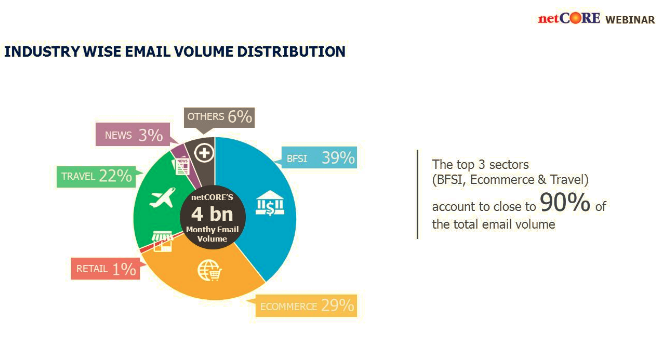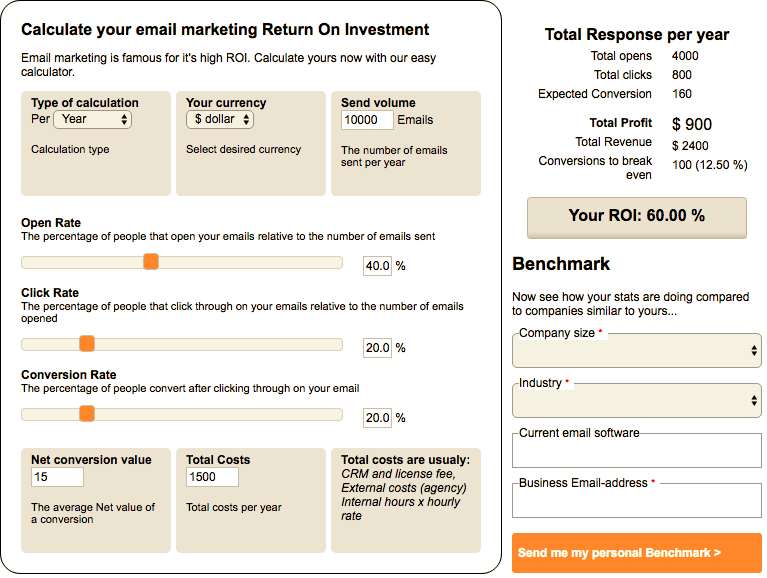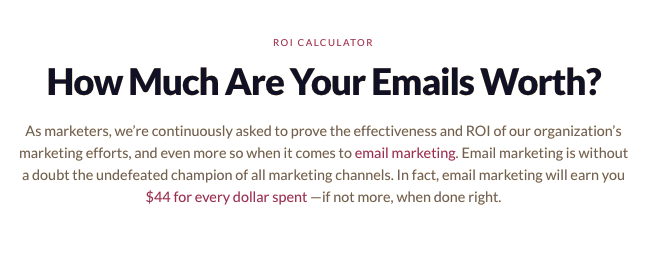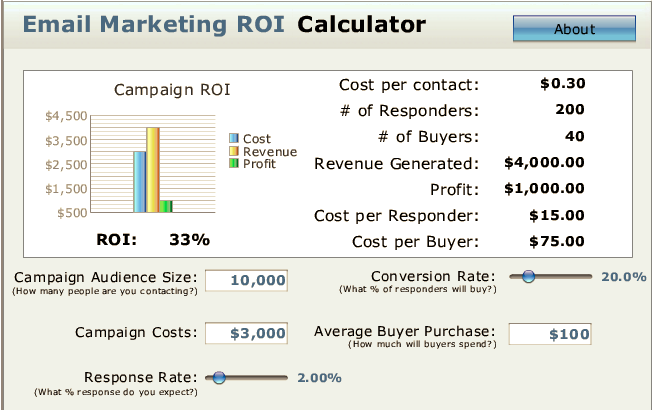Is email marketing still a trustable investment channel in today’s competitive market?
The answer is yes. For every $1 spent, the email marketing ROI (Return on investment) is $38.
It is more than double compared to any digital marketing tools in the market.
You can consider stable customer relationship, retention, and better conversion. Marketers around the world believe in email marketing.
Have you ever wondered if maintaining a high ROI is your marketing goal?
In this post, we are going to help you how to calculate your email marketing ROI, the different ROI measurements and goals. And, some of the best ROI calculators you can use.
What is Email Marketing ROI?
Return on investment is a performance measurement to evaluate any of your business investment. You can use it to compare the success of your email marketing with a bunch of other investments too.
Marketers use ROI for two prominent reasons.
i. Find out how successful their email marketing campaign is.
ii. How much they should spend in their next email marketing strategy.
The general email marketing ROI formula is:
(Gained – Spent) / Spent = ROI%
So, here profit gaining and spent is the main factor. These are the two major value. You must learn them well to get proper control over your return on investment.
Take a look below:
Gained value means your total earnings in a single financial period.
How are you going to find this out?
You need to define your exact source of sales or conversions which aid you to get that.
You must integrate your email campaign with Google Analytics.
It will help to track all the purchases made from an email in a specific time.
The next one is your investment or money you’ve spent in your email campaign.
It includes everything you’ve spent. Like- email automation platform or service provider, salaries of email marketers, designers, copywriters, and other people helping your email marketing strategy to become a success.
Now you get an idea on the two prominent factors needs to calculate your email marketing ROI. Let’s dig a more dipper.
Why is it So Essential to Calculate your Email Marketing ROI?
Before you implement a strong email marketing strategy, you need to set your measurable goals following the types of your business.
Next, to track the progress of your business, you must improve your KPIs (Key Performance Indicator).
You must not execute generic email plan rather than triggered and segmented email to different types of customers.
According to DMA, 77% of ROI comes from segmented, targeted and triggered campaigns.
Your email marketings strategy depends on what types of business you have. Though, there are some common grounds regarding email ROI.

Almost 29% of total email sent from the eCommerce industry. The largest sector here is the banking and financial industries (39%).
There are different email marketing ROI measurements considering every industry.
We are going to discuss some of the top measurements and goals here. Which can go for any business you are up to investment.
Sales and Conversions
All of your leads are not sales-ready like all of your visitors not going to end up being your leads. Email works as a crucial trigger to move your customer from sales funnel to final conversion.
When someone comes to your website, you deliver reasons to make him feel interested. If you succeed, eventually you make him a lead.
Sales and conversion heavily depend on lead nurturing. Unless you nurture a lead, making a conversion is impossible.
No matter what you do, don’t pass leads directly to the sales team.
Jon Miller, CEO, and co-founder, Engagio
As a marketer, it’s your job to building a long-term relationship with your leads.
I mean, you must have intentions to do so. It’s not like once you convert someone, that’s the end of a business relationship.
A long-term lead considers as a vital asset for your business.
A customer who made a purchase once, the chance here is 60% that he will purchase at least one more time.
Acquiring new customers cost 5x more than retaining the old ones.
Emails influence your user to make a purchase. It impacts your overall lead nurturing processes like –
- User engagement
- Track lead acceleration
- Impact on revenue, etc.
Let’s see how they work:
i. Engagement helps to know how your emails can connect users.
It shows either your emails are engaging them to react, track open rate, CTR, and conversion rate or not.
ii. How fast your email makes a user move from one step to the next in a buying cycle?
Email marketing acceleration rate helps you to find this out.
Acceleration rate unravels the time-consumption of your emails, and you learn how fast your emails take to get someone acts toward conversion.
iii. Impact on revenue demonstrates how your email campaign help to create your company revenue over a specified financial cycle.
Customers come through multiple steps before making a purchase. Which tool or a motivator working more?
It can be your website, Facebook page or social media review, etc.
Add specific value to each motivator. Implement more effort to the successful one.
Website Traffic as an Integral Part of Email Marketing ROI
You can bring back your website traffic with email marketing. It is also one of the crucial goals of this marketing channel.
People often forget or may detach from your website after the opt-in process. You shouldn’t let them do that. One of the most effective ways is sending them emails packed with maximum value.
Make them familiar with your services and offers – that’s the key.
Though, there are other channels you may use for driving your website traffic. Email marketing seems not resting from doing this job even more patiently.
Do you want to check that? How are your email marketing intrigued users to visit your website? Let’s take a closer look into these metrics below.
Click Through Rate: How many of your user clicks on the link of your emails? CTR meant to help you get the numbers.
To measure CTR of your email:
Divide the number of unique clicks by the number of delivered emails. Now multiply it with 100%.
Click To Open Rate: CTOR help you to know how many people who open your emails clicked on the link.
The calculation process is more or less the same. Divide the unique clicks by the number of unique opens. Multiply it with 100%.
You can use these two metrics CTR and CTOR to understand your emails impact.
How connecting and helpful your email content and CTA buttons are, how users like to interact with them. The higher number ensures a lot of traffic boost.
Also, you can find out how many purchases your subscribers make using a particular link attached with the emails.
And compare the number with the purchase of a regular visitor. You will get a clear idea of how your email campaign is performing.
Brand Awareness has a Key Influence on Email Marketing ROI
People depend on others opinion before buying a product.
They love to hear reviews and comments from their surroundings. If it is not available, they most likely choose a renown brand from the lot.
89% of B2B marketers believe brand awareness is their most important goal.
It’s pretty clear. A customer feels safer when he chose a familiar brand rather than an unfamiliar one.
No doubt, email marketing is a widely popular marketing weapon to increase brand awareness.
When a subscriber read an email, it hit the right cords, it sounds profitable and takes him to make a conversion.
Email marketing can initiate a healthy customer relationship.
You can regularly interact with your customer using these channels. Help them understand your brand value.
A strategic and triggered email campaign influence users to share your content via social media and another possible way to reach a wider audience.
Though, there is no specific way to perceive the idea. How your email campaign increase your brand awareness?
It is certainly doing the job, but how are you going to find it?
Let’s check out these top trends here.
Direct Website Traffic: Check how many times a visitor type your site name directly in their browser. And how many of them are in your subscription list.
This trend let you know how your email campaign brings direct traffic. Or how your direct user become your regular subscribers. Vice versa.
Link Building: Check your external links. From where do they come to you? Analyze each one particularly.
Does anyone of them come from your email campaign recipients?
It will show you how your brand awareness impacts your email marketing ROI.
Top Email Marketing ROI Calculators in the Market
It is essential to do manual research regarding every aspect of your email marketing strategy.
We have already discussed that email marketing ROI is a vast topic. It plays a crucial role in your marketing success.
Though, for the basic results to start, these ROI calculators can help you a lot. They generate sharp, automated, and faster output.
Let’s check them out.
One of the most popular email marketing ROI calculators online. It is a separate website with enhanced tools to calculate your ROI. Just put your data and let the tools calculate them. Put your industry name and email address.

Sleeknote comes with a cool email marketing ROI calculators. You need to put the necessary information. And they show results. It’s easy to use, generate a reliable statement.

At first, you need to set your currency. Then put this info correctly.
- Send Volume
- Campaign’s Cost
- Open Rate
- CTR
- Conversion Rate
- Average Value of Conversion

BPlanns offers a bunch of different financial calculators regarding your every marketing strategy. Its email marketing ROI calculator is easy to use, produce perfect results. You can use their embed code to integrate it to your website at ease.
So, these are the top three email marketing ROI calculators you can get aid.
Final Thoughts
To find out the email marketing ROI, you can divide the difference between the investment and profit by your email investments.
Only 30% of brands measure their true ROI. It happens because marketers often underestimate the importance.
While you gain an accurate idea about your email marketing ROI, it will ensure your chance to run a robust email campaign.
Want to maintain a stable ROI?
You can always get aid from the best email marketing automation tools like OmniKick.
